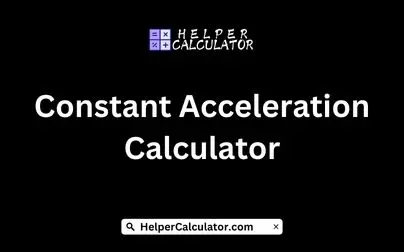A "Constant Acceleration Calculator" is a tool that helps determine various parameters related to an object's motion when it is experiencing constant acceleration.
This calculator is particularly useful in physics and engineering applications where understanding the motion of objects under constant acceleration is essential.
Key parameters that can be calculated using a Constant Acceleration Calculator include:
1. Final Velocity (vf): The velocity of the object at the end of the acceleration period.
2. Initial Velocity (vi): The velocity of the object at the beginning of the acceleration period.
3. Acceleration (a): The rate at which the object's velocity changes over time.
4. Time (t): The duration of the acceleration period.
The calculator typically requires users to input known values such as initial velocity, acceleration, time, or final velocity, depending on the specific calculation they want to perform. The calculator then uses the equations of motion under constant acceleration to compute the desired parameter.
The equations commonly used in constant acceleration calculations include:
1. Final Velocity (vf) Calculation:
vf = vi + at
2. Distance Traveled (d) Calculation:
d = vi * t + 0.5 * a * t^2
3. Acceleration (a) Calculation:
a = (vf - vi) / t
4. Time (t) Calculation:
t = (vf - vi) / a
By incorporating these formulas into the Constant Acceleration Calculator, users can easily determine the final velocity, distance traveled, acceleration, or time taken for an object undergoing constant acceleration.
This tool can be beneficial for students, researchers, and professionals working in physics, mechanics, or any field where understanding acceleration is crucial.
